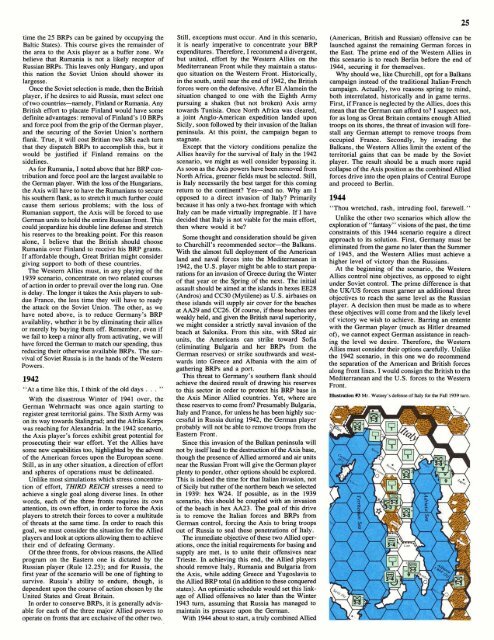18.64MB - View From The Trenches
18.64MB - View From The Trenches
18.64MB - View From The Trenches
- TAGS
- trenches
- www.vftt.co.uk
You also want an ePaper? Increase the reach of your titles
YUMPU automatically turns print PDFs into web optimized ePapers that Google loves.
time the 25 BRPs can be gained by occupying the<br />
Baltic States). This course gives the remainder of<br />
the area to the Axis player as a buffer zone. We<br />
believe that Rumania is not a likely receptor of<br />
Russian BRPs. This leaves only Hungary, and upon<br />
this nation the Soviet Union should shower its<br />
largesse.<br />
Once the Soviet selection is made, then the British<br />
player, if he desires to aid Russia, must select one<br />
of two countries-namely, Finland or Rumania. Any<br />
British effort to placate Finland would have some<br />
definite advantages: removal of Finland's 10 BRPs<br />
and force pool from the grip of the German player,<br />
and the securing of the Soviet Union's northern<br />
flank. True, it will cost Britian two SRs each turn<br />
that they dispatch BRPs to accomplish this, but it<br />
would be justified if Finland remains on the<br />
sidelines.<br />
As for Rumania, I noted above that her BRP con-<br />
tribution and force pool are the largest available to<br />
the Gennan player. With the loss of the Hungarians,<br />
the Axis will have to have the Rumanians to secure<br />
his southern flank, as to stretch it much further could<br />
cause them serious problems; with the loss of<br />
Rumanian support, the Axis will be forced to use<br />
German units to hold the entire Russian front. This<br />
could jeopardize his double line defense and stretch<br />
his reserves to the breaking point. For this reason<br />
alone, I believe that the British should choose<br />
Rumania over Finland to receive his BRP grants.<br />
If affordable though, Great Britian might consider<br />
giving support to both of these countries.<br />
<strong>The</strong> Western Allies must, in any playing of the<br />
1939 scenario, concentrate on two related courses<br />
of action in order to prevail over the long run. One<br />
is delay. <strong>The</strong> longer it takes the Axis players to sub-<br />
due France, the less time they will have to ready<br />
the attack on the Soviet Union. <strong>The</strong> other, as we<br />
have noted above, is to reduce Germany's BRP<br />
availablity, whether it be by eliminating their allies<br />
or merely by buying them off. Remember, even if<br />
we fail to keep a minor ally from activating, we will<br />
have forced the German to match our spending, thus<br />
reducing their otherwise available BRPs. <strong>The</strong> sur-<br />
vival of Soviet Russia is in the hands of the Western<br />
Powers.<br />
"At a time like this, I think of the old days . . . "<br />
With the disastrous Winter of 1941 over, the<br />
German Wehrmacht was once again starting to<br />
register great territorial gains. <strong>The</strong> Sixth Army was<br />
on its way towards Stalingrad; and the Afrika Korps<br />
was reaching for Alexandria. In the 1942 scenario,<br />
the Axis player's forces exhibit great potential for<br />
prosecuting their war effort. Yet the Allies have<br />
some new capabilities too, highlighted by the advent<br />
of the American forces upon the European scene.<br />
Still, as in any other situation, a direction of effort<br />
and spheres of operations must be delineated.<br />
Unlike most simulations which stress concentra-<br />
tion of effort, THIRD REICH stresses a need to<br />
achieve a single goal along diverse lines. In other<br />
words, each of the three fronts requires its own<br />
attention, its own effort, in order to force the Axis<br />
players to stretch their forces to cover a multitude<br />
of threats at the same time. In order to reach this<br />
goal, we must consider the situation for the Allied<br />
players and look at options allowing them to achieve<br />
their end of defeating Germany.<br />
Of the three fronts, for obvious reasons, the Allied<br />
program on the Eastern one is dictated by the<br />
Russian player (Rule 12.25); and for Russia, the<br />
first year of the scenario will be one of fighting to<br />
survive. Russia's ability to endure, though, is<br />
dependent upon the course of action chosen by the<br />
United States and Great Britain.<br />
In order to conserve BRPs, it is generally advis-<br />
able for each of the three major Allied powers to<br />
operate on fronts that are exclusive of the other two.<br />
Still, exceptions must occur. And in this scenario,<br />
it is nearly imperative to concentrate your BRP<br />
expenditures. <strong>The</strong>refore, I recommend a divergent,<br />
but united, effort by the Western Allies on the<br />
Mediterranean Front while they maintain a status-<br />
quo situation on the Western Front. Historically,<br />
in the south, until near the end of 1942, the British<br />
forces were on the defensive. After El Alamein the<br />
situation changed to one with the Eighth Army<br />
pursuing a shaken (but not broken) Axis army<br />
towards Tunisia. Once North Africa was cleared,<br />
a joint Anglo-American expedition landed upon<br />
Sicily, soon followed by their invasion of the Italian<br />
peninsula. At this point, the campaign began to<br />
stagnate.<br />
Except that the victory conditions penalize the<br />
Allies heavily for the survival of Italy in the 1942<br />
scenario, we might as well consider bypassing it.<br />
As soon as the Axis powers have been removed from<br />
North Africa, greener fields must be selected. Still,<br />
is Italy necessarily the best target for this coming<br />
return to the continent? Yes-and no. Why am I<br />
opposed to a direct invasion of Italy? Primarily<br />
because it has only a two-hex frontage with which<br />
Italy can be made virtually impregnable. If I have<br />
decided that Italy is not viable for the main effort,<br />
then where would it be?<br />
Some thought and consideration should be given<br />
to Churchill's recommended sector-the Balkans.<br />
With the almost full deployment of the American<br />
land and naval forces into the Mediterranean in<br />
1942, the U.S. player might be able to start prepa-<br />
rations for an invasion of Greece during the Winter<br />
of that year or the Spring of the next. <strong>The</strong> initial<br />
assault should be aimed at the islands in hexes EE28<br />
(Andros) and CC30 (Mytilene) as U.S. airbases on<br />
these islands will supply air cover for the beaches<br />
at AA29 and CC26. Of course, if these beaches are<br />
weakly held, and given the British naval superiority,<br />
we might consider a strictly naval invasion of the<br />
beach at Salonika. <strong>From</strong> this site, with SRed air<br />
units, the Americans can strike toward Sofia<br />
(eliminating Bulgaria and her BRPs from the<br />
German reserves) or strike southwards and west-<br />
wards into Greece and Albania with the aim of<br />
gathering BRPs and a port.<br />
This threat to Germany's southern flank should<br />
achieve the desired result of drawing his reserves<br />
to this sector in order to protect his BRP base in<br />
the Axis Minor Allied countries. Yet, where are<br />
these reserves to come from? Presumably Bulgaria,<br />
Italy and France, for unless he has been highly suc-<br />
cessful in Russia during 1942, the German player<br />
probably will not be able to remove troops from the<br />
Eastern Front.<br />
Since this invasion of the Balkan peninsula will<br />
not by itself lead to the destruction of the Axis base,<br />
though the presence of Allied armored and air units<br />
near the Russian Front will give the German player<br />
plenty to ponder, other options should be explored.<br />
This is indeed the time for that Italian invasion, not<br />
of Sicily but rather of the northern beach we selected<br />
in 1939: hex W24. If possible, as in the 1939<br />
scenario, this should be coupled with an invasion<br />
of the beach in hex AA23. <strong>The</strong> goal of this drive<br />
is to remove the Italian forces and BRPs from<br />
German control, forcing the Axis to bring troops<br />
out of Russia to seal these penetrations of Italy.<br />
<strong>The</strong> immediate objective of these two Allied oper-<br />
ations, once the initial requirements for basing and<br />
supply are met, is to unite their offensives near<br />
Trieste. In achieving this end, the Allied players<br />
should remove Italy, Rumania and Bulgaria from<br />
the Axis, while adding Greece and Yugoslavia to<br />
the Allied BRP total (in addition to these conquered<br />
states). An optimistic schedule would set this link-<br />
age of Allied offensives no later than the Winter<br />
1943 turn, assuming that Russia has managed to<br />
maintain its pressure upon the German.<br />
With 1944 about to start, a truly combined Allied<br />
(American, British and Russian) offensive can be<br />
launched against the remaining German forces in<br />
the East. <strong>The</strong> prime end of the Western Allies in<br />
this scenario is to reach Berlin before the end of<br />
1944, securing it for themselves.<br />
Why should we, like Churchill, opt for a Balkans<br />
campaign instead of the traditional Italian-French<br />
campaign. Actually, two reasons spring to mind,<br />
both interrelated, historically and in game terms.<br />
First, if France is neglected by the Allies, does this<br />
mean that the German can afford to? I suspect not,<br />
for as long as Great Britain contains enough Allied<br />
troops on its shores, the threat of invasion will fore-<br />
stall any German attempt to remove troops from<br />
occupied France. Secondly, by invading the<br />
Balkans, the Western Allies limit the extent of the<br />
territorial gains that can be made by the Soviet<br />
player. <strong>The</strong> result should be a much more rapid<br />
collapse of the Axis position as the combined Allied<br />
forces drive into the open plains of Central Europe<br />
and proceed to Berlin.<br />
"Thou wretched, rash, intruding fool, farewell."<br />
Unlike the other two scenarios which allow the<br />
exploration of "fantasy" visions of the past, the time<br />
constraints of this 1944 scenario require a direct<br />
approach to its solution. First, Germany must be<br />
eliminated from the game no later than the Summer<br />
of 1945, and the Western Allies must achieve a<br />
higher level of victory than the Russians.<br />
At the beginning of the scenario, the Western<br />
Allies control nine objectives, as opposed to eight<br />
under Soviet control. <strong>The</strong> prime difference is that<br />
the UKlUS forces must garner an additional three<br />
objectives to reach the same level as the Russian<br />
player. A decision then must be made as to where<br />
these objectives will come from and the likely level<br />
of victory we wish to achieve. Barring an entente<br />
with the German player (much as Hitler dreamed<br />
of), we cannot expect German assistance in reach-<br />
ing the level we desire. <strong>The</strong>refore, the Western<br />
Allies must consider their options carefully. Unlike<br />
the 1942 scenario, in this one we do recommend<br />
the separation of the American and British forces<br />
along front lines. I would consign the British to the<br />
Mediterranean and the U.S. forces to the Western<br />
Front.<br />
Illustration #3 Mr. Watney's defense of Italy for the Fall 1939 Nm.
















